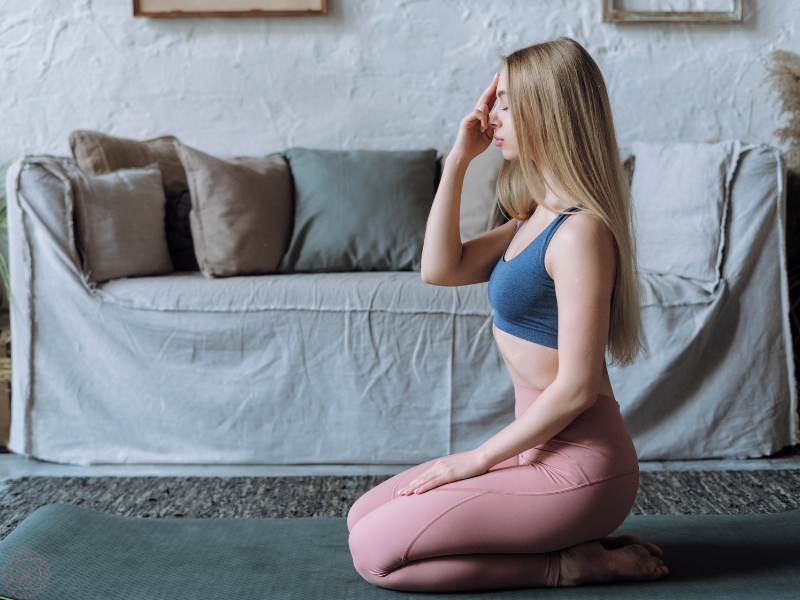Breathing is an essential part of life, and its power extends beyond mere survival. In the world of yoga, the practice of controlling breath, known as pranayama, is a cornerstone for achieving mental clarity, emotional balance, and physical well-being. The word “pranayama” originates from Sanskrit, combining “prana,” meaning life force or vital energy, and “ayama,” meaning extension or control. This ancient practice is a profound tool for enhancing one’s overall health and well-being.
Pranayama is not just about deep breathing; it involves specific techniques that can have profound effects on the mind and body. This post explores 7 types of pranayama. These practices are suitable for beginners and seasoned practitioners alike, each offering unique benefits. But first, let’s delve deeper into what pranayama is and its origins.

What is Pranayama?
Pranayama is an integral component of yoga, often described as the practice of breath control. It is mentioned in ancient yogic texts, such as the Yoga Sutras of Patanjali and the Hatha Yoga Pradipika. Pranayama is not merely a breathing exercise; it is a discipline aimed at purifying the mind and body, enhancing concentration, and promoting spiritual growth.
The practice of pranayama involves various breathing techniques that regulate the flow of prana within the body. By consciously controlling the breath, one can influence the flow of energy, balance the nervous system, and cultivate a calm mind. It is believed that mastering pranayama can lead to greater control over one’s thoughts, emotions, and overall life force.
Let’s explore the 7 types of pranayama, detailing their benefits and how to perform them.
1. Nadi Shodhana (Alternate Nostril Breathing)
Nadhi Shodana, also known as alternate nostril breathing, is a calming pranayama technique. It balances the left and right hemispheres of the brain (also known as Ida and Pingala Nadi), promoting mental clarity and emotional stability.
How to Perform Nadi Shodhana:
- Sit in a comfortable position with your spine straight.
- Close your right nostril with your right thumb.
- Inhale deeply through your left nostril.
- Close your left nostril with your ring finger and exhale through your right nostril.
- Inhale through your right nostril, then close it and exhale through the left.
- Continue this cycle for several minutes.
Benefits:
- Reduces stress and anxiety
- Enhances focus and concentration
- Balances the nervous system
2. Sheetali (Cooling Breath)
Sheetali pranayama, also known as cooling breath, helps to reduce body heat and calm the mind. It is especially beneficial during hot weather or for those experiencing hot flashes.
How to Perform Sheetali:
- Sit comfortably and roll your tongue into a tube shape.
- Inhale slowly through the rolled tongue, filling your lungs.
- Close your mouth and exhale slowly through your nose.
- Repeat for several breaths.
Benefits:
- Cools the body
- Reduces anger and anxiety
- Aids in digestion
3. Sitkari (Hissing Breath)
Sitkari pranayama is another cooling technique, similar to Sheetali, but with a different method of inhalation. It helps to soothe the mind and body, especially during times of stress.
How to Perform Sitkari:
- Sit in a comfortable position with your spine straight.
- Press your tongue against the upper palate.
- Inhale through the teeth, creating a hissing sound.
- Close your mouth and exhale through the nose.
- Repeat for several minutes.
Benefits:
- Cools the body and mind
- Reduces high blood pressure
- Promotes relaxation
4. Ujjayi (Victorious Breath)
Ujjayi pranayama, known as the victorious breath, is characterized by a soft, oceanic sound created during exhalation. This practice is often used during asana practice to maintain a steady flow of breath.
How to Perform Ujjayi:
- Sit comfortably or practice during your yoga asanas.
- Inhale deeply through your nose, filling your lungs.
- Slightly constrict your throat and exhale slowly through your nose, creating a gentle ocean-like sound.
- Maintain a steady rhythm and continue for several minutes.
Benefits:
- Calms the mind
- Increases concentration
- Improves lung capacity
5. Surya Bhedana (Right Nostril Breathing)
Surya Bhedana pranayama, or right nostril breathing, is a warming technique that energizes the body and stimulates the sympathetic nervous system. It is ideal for those who feel lethargic or need a boost of energy. This technique activates our solar channel, or Pingala Nadi.
How to Perform Surya Bhedana:
- Sit comfortably with a straight spine.
- Close your left nostril with your ring finger.
- Inhale deeply through your right nostril.
- Close your right nostril and exhale through your left nostril.
- Continue the cycle, always inhaling through the right nostril and exhaling through the left.
Benefits:
- Increases energy and alertness
- Stimulates the digestive system
- Warms the body
6. Chandra Bhedana (Left Nostril Breathing)
Chandra Bhedana pranayama, or left nostril breathing, is the counterpart to Surya Bhedana. It is a cooling and calming practice, ideal for reducing stress and promoting relaxation. This technique activates our lunar channel, or Ida Nadi.
How to Perform Chandra Bhedana:
- Sit in a comfortable position with your spine straight.
- Close your right nostril with your thumb.
- Inhale deeply through your left nostril.
- Close your left nostril and exhale through your right nostril.
- Repeat the cycle, always inhaling through the left nostril and exhaling through the right.
Benefits:
- Calms the nervous system
- Reduces stress and anxiety
- Lowers body temperature
7. Kapalabhati (Skull Shining Breath)
Kapalabhati pranayama, also known as skull shining breath, is a vigorous practice that involves rapid, forceful exhalations. It is a powerful cleansing technique that energizes the body and clears the mind.
How to Perform Kapalabhati:
- Sit comfortably with your spine straight.
- Take a deep breath in, then exhale forcefully through the nose, pulling your navel towards your spine.
- Allow the inhalation to be passive and natural.
- Continue with rapid exhalations for 20-30 breaths, then take a deep breath and relax.
Benefits:
- Detoxifies the lungs and respiratory system
- Increases energy and vitality
- Improves digestion
Note: While this post focuses on 7 types of pranayama—Nadi Shodhana, Sheetali, Sitkari, Ujjayi, Surya Bhedana, Chandra Bhedana, and Kapalabhati—there are many other pranayama techniques with their own unique benefits and methods.

How Long, How Often, and When to Practice Pranayama
Establishing a consistent pranayama practice can greatly enhance its benefits. Here’s a guide on how long, how often, and the best times to practice these 7 types of pranayama:
How Long to Practice
The duration of your pranayama practice can vary based on your experience level and individual needs:
- Beginners: Start with 5-10 minutes per session, focusing on one or two pranayama techniques. Gradually increase the duration as you become more comfortable.
- Intermediate: Practice for 15-20 minutes, incorporating a variety of pranayamas to balance different effects.
- Advanced: 20-30 minutes or more, allowing for deeper exploration and prolonged practice of each technique.
How Often to Practice
Consistency is key to gaining the full benefits of pranayama. Here are some general guidelines:
- Daily Practice: For maximum benefits, aim to practice pranayama daily. This helps to build a strong foundation and brings about noticeable improvements in physical and mental well-being.
- Frequency: If daily practice isn’t feasible, try to practice at least 3-4 times a week. This regularity still provides significant benefits.
- Multiple Sessions: On days when you have more time, consider practicing pranayama in the morning and evening. Morning sessions can energize you for the day ahead, while evening sessions can help you unwind and relax.
When to Practice
Choosing the right time to practice pranayama can enhance its effectiveness:
- Morning: Practicing pranayama in the morning is ideal. The air is fresh, and the mind is calm, making it easier to focus. Morning practice can energize the body and set a positive tone for the day.
- Evening: Evening practice can help to relax the mind and body, releasing the stress and tension accumulated during the day. It’s particularly beneficial if you’re winding down before bed.
- Empty Stomach: Always practice pranayama on an empty stomach or at least 2-3 hours after a meal. This prevents discomfort and allows for deeper breathing.
Tailoring Your Practice
Consider your individual needs and health conditions when determining how long and how often to practice pranayama. Listen to your body and avoid overexertion. Start slowly, and gradually increase the duration and intensity of your practice. Consulting with a certified yoga instructor can provide personalized guidance and ensure you’re practicing safely and effectively.
By incorporating these practices into your daily routine, you can experience the wonderful benefits of pranayama, including enhanced mental clarity, reduced stress, and improved overall well-being.
FAQs: Frequently Asked Questions About Pranayama
1. What should I do if I feel dizzy or uncomfortable during pranayama?
If you feel dizzy, lightheaded, or uncomfortable during pranayama, stop immediately and return to normal breathing. It’s important to listen to your body and not force the breath. These sensations may occur if you’re practicing too intensely or not properly prepared. Try practicing in a well-ventilated space, and avoid overexertion.
2. Can pranayama help with stress and anxiety?
Yes, pranayama is a powerful tool for managing stress and anxiety. Techniques like Nadi Shodhana and Chandra Bhedana are particularly effective for calming the mind and balancing the nervous system. Regular practice can help reduce symptoms of anxiety and promote a sense of inner peace and relaxation.
3. Can pranayama improve lung capacity and respiratory health?
Yes, pranayama can significantly improve lung capacity and overall respiratory health. Techniques like Ujjayi and Kapalabhati help strengthen the respiratory muscles and increase lung capacity. Regular practice can enhance oxygen intake and improve overall respiratory function.
4. Can pranayama be practiced alongside other forms of exercise?
Yes, pranayama can complement other forms of exercise, such as yoga, meditation, or even cardiovascular workouts. It can be practiced before or after other activities to enhance focus, relaxation, and overall performance. However, ensure you’re practicing pranayama on an empty stomach and in a calm environment.
Precautions and Considerations
While pranayama offers numerous benefits, it’s important to practice with caution, especially if you have specific health concerns. Here are some precautions to consider:
- Kapalabhati: Avoid if you have high blood pressure, heart conditions, or are pregnant.
- Surya Bhedana: Use caution if you have a fever or are prone to anxiety.
- Chandra Bhedana: Not recommended if you have low blood pressure or are feeling overly fatigued.

Final Reflections
Incorporating these 7 types of pranayama into your daily routine can have transformative effects on your physical, mental, and emotional well-being. Whether you’re looking to energize your body, calm your mind, or balance your emotions, there is a pranayama technique suited for your needs. Remember to practice mindfully and listen to your body, and you will reap the benefits of these ancient breathing exercises.
This post was all about 7 types of Pranayama.
Other Posts You May Like:
Hi love!
I’m a Nutritional Therapy Practitioner and Dharmic Healer looking to guide you back to your true Self through various mind, body, and spirit healing modalities.
I’m Rana.
LEARN MORE
Leave a Reply Cancel reply
Rana is a Nutritional Therapy Practitioner and Dharmic Healer here to guide you back to your true Self through various mind, body, and spirit healing modalities.
HOME
ABOUT
CONTACT
BLOG
SHOP
OFFERINGS
© Mantras and Mulberries.